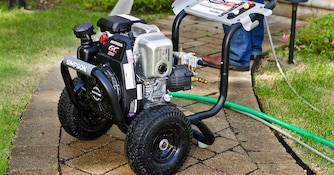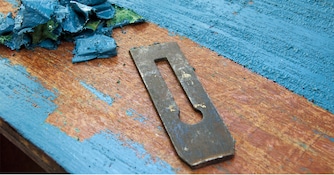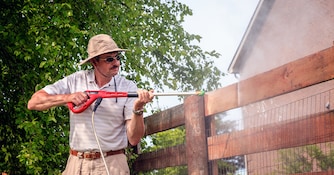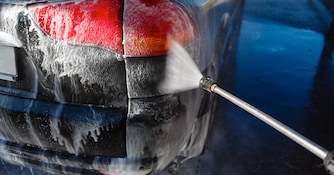
Cleaning and Refinishing a Deck
If cleanliness is next to godliness, staining a deck should be a heavenly experience. But, if you opt to sand your deck first, the dust-raising experience can leave you squinting like a one-eyed pirate.
Sanding your deck may achieve the desired result, but the gritty experience is less than desirable. The deep-cleaning action of a pressure washer will remove ground-in dirt, mold, and mildew without all the mess.
Use a mid-sized pressure washer with at least 2400 PSI of pressure. Smaller models will work, but you'll definitely appreciate a canyon-clearing stream of a mid- to large-sized model versus a small water pick.
Cleaning Tips
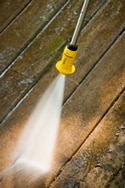
- Spray water over your deck to rinse off loose dirt and leaves.
- Using the chemical tip on the wand of your pressure washer, liberally apply a chemical solution made specifically for decks and fences. Allow the solution to sit for a few minutes.
- Switch tips to a narrow spray for heavy cleaning, using stroking motions to loosen grime and grunge off your deck. Do not use the most narrow spray - 0 degrees - which is powerful enough to carve your initials into a deck.
- Rinse your deck with a water spray and allow it to dry for 48 hours.
A Consistent Clean
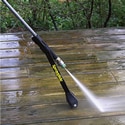
You'll be using your deck all summer long so you want it looking its finest. You don't want any streaks, but it can be difficult to achieve a consistent clean with a spray gun. Good news, Sprayglide® can help. This inexpensive roller will reduce fatigue, helping you achieve evenly clean surfaces.
Sprayglide® fastens with commercial-grade Velcro and allows the user to adjust the spray height for the ideal setting relative to their physical height, the pressure washer's PSI, and spray wand length. The spray can be pointed safely away from the user, and the spray distance from the surface can be easily adjusted as needed.
Staining Tips
- Protect your arms and legs with a long-sleeved shirt and long pants, and your eyes with goggles. If you're using a solvent-based product, wear a mask to protect against inhalation.
- Make sure temperatures are between 50 and 90 degrees Fahrenheit and do not apply if other conditions - including rain or high winds - are expected within the next day or two.
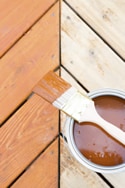 Select a stain that is mixed with a sealer. Test the stain on a separate piece of wood to make sure it matches the color that you want.
Select a stain that is mixed with a sealer. Test the stain on a separate piece of wood to make sure it matches the color that you want.- Pour four gallons of stain into a five-gallon pail, mixing thoroughly with a long paddle. Then pour some of the stain into a smaller pail for your brushwork on the railings and benches, and use the larger pail for your roller on the deck floor.
- Liberally apply the stain to the point of saturation. All exposed ends should be coated several times until all pores are saturated.
![]() Shop All Pressure Washer Detergents
Shop All Pressure Washer Detergents


